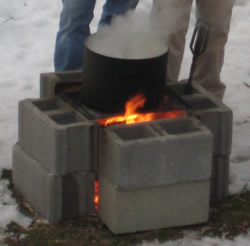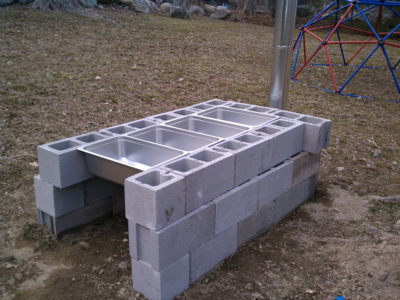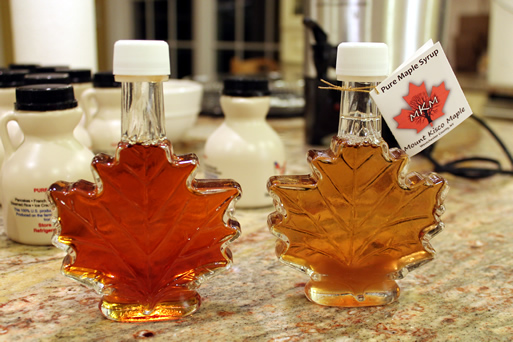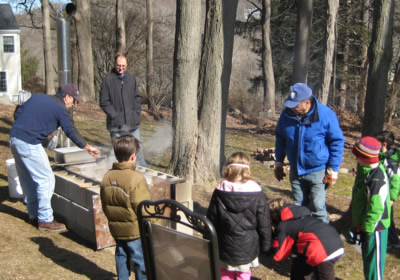History of Mount Kisco Maple
I first visited the property that was to be our current home in October of 2001 and took notice of the one-acre yard which seemed to be knee-high in fallen leaves. I would spend years battling the autumn leaves with landscapers and alone with rakes, tarps, and various leaf blowers. We had a tree service remove and trim many of the trees on the overgrown property and inform us that most of our trees were sugar maples or what he called "rock" maple. I didn't think much of it at the time.
I spent many years managing the leaves and fallen branches. I also understood that the huge canopy of leaves that prevented sunlight getting in and grass growing, could also keep me quite dry when it rained.
After one March storm, I needed to trim a bunch of broken branches. So with pole saw in hand I began my work as sawdust, and what I thought was water, rained down upon me. After further reflection, I realized it was maple sap. When most people think of sap, they think of thick and sticky pine sap, but maple sap is mostly water. There is only a small amount of sugar, which you can hardly even taste. This is why making syrup is so labor intensive, because you have to condense it by boiling off the water. The ratio is about 40:1, meaning it would take about 40 gallons of sap to make 1 gallon of syrup. (See How Syrup is Made)
I began researching how to make syrup and learned the best time to tap trees, how much sap to expect, what yield to expect and how long it might take. Even after learning all that, I still decided to go ahead with it!
Year One - Success
So in February of 2011, I ordered some buckets and taps (see Resources), and drilled holes in 4 of my trees. The sap began to flow and I collected it in a few 6-gallon buckets.
Since so much water needs to be boiled off, and so much heating fuel is needed, it is best to do the boiling outside, and my first "evaporator" was a few cement blocks and an old aluminum pot.

Without knowing the finer details of surface area, liquid volume, and heat distribution, I spent an entire day of daylight out by the fire reducing the sap more and more. Once it got to a manageable amount, I brought the operation inside. Especially since it was now dark and I was frozen.
I had read about final boil temperatures, boil overs, filtering, and bottling and all seemed to go well. Although I had almost forgotten to taste the final product along the way -- it was delicious! As good as the best syrup you could buy. But was it worth it? Couldn't you just buy maple syrup? No matter, I was hooked. In my own yard I could tap trees, burn wood, drink beer, hang out with friends, family, and neighbors, and end up with something no one could believe you could make yourself. (At least not in my neck of the woods.)
I boiled a few more times that season and the syrup got progressively darker, which is expected. I was able to give a bit away and enjoy the rest, and as the season came to a close, I began to dream of ways to make it easier and yield more syrup.
Year Two - Achievements and Failure
As the 2012 season approached, I was determined to get better results. I had plenty of trees that yielded plenty of sap. My limiting factor was the time it took to boil. My research told me that I needed to increase the surface area and decrease the depth of the boiling sap. "Real" maple syrup makers have elaborate and expensive stainless steel evaporator pans and arches costing thousands of dollars. I did the math, and although I like spending money on hobbies, I couldn't justify spending anywhere near that much. I scoured the web and stuck my nose into a book that would become my best investment: Backyard Sugarin': A Complete How-To Guide by Rink Mann. Through inspiration and research I came up with a design using cement blocks, catering trays, and some duct work.

cement block evaporator
With so much more surface area and a more efficient heating system, I cut my time down to only a few hours and boiled through all of the sap I had collected. Reveling in my success, I placed an order for more taps and buckets to collect even more sap.
Ramping up to ten taps gave me more sap than I could store, so I had to take a day off of work just to keep up. Working solo was peaceful, but I missed the company of friends, neighbors, and especially my dad who could match my endurance and provided grounded wisdom.
Things were going very well until it came time to transfer the almost-ready syrup, around one decent gallon, to the old boiling pot to bring inside for finishing. Perhaps it was the cumbersome nature of the tray, the lack of the proper fire-resistant gloves, the rushed feeling of a pending appointment in the evening, but whatever those factors, the pan slipped, and I lost the whole batch when it spilled into the fire providing a huge mushroom cloud of steam.
My eldest son was home from school and witnessed the whole thing. I could have sworn; I could have cried; but instead I kind of just sat down and said "oh well." I learned then, that it wasn't so much about the syrup; it was the process - the whole event. It was also a teaching moment about failure and perseverance. We joked that we would never mention it to anyone, but with my red eyes from the smoke plume and red arms from steam burns, it was hard to hide. I also learned about welders gloves.
I boiled once more that season - on St. Patrick's Day. It had been warm, and late in the season. I suspected that the season might be over and syrup wouldn't be the best, but I was determined to recover from my failure. I also had some friends interested in the process, and drinking beer, so we had one last boil.
Everything went great. No accidents and a good time with friends, but the syrup was very dark and a little bitter. The season was over, but I was happy that the process worked and looked forward to next year when I would be ready with many taps, higher capacity storage, more firewood, and the itch to stand out in the cold near a burning fire for hours to produce something you can easily buy in a store.
Year Three (and beyond) - Continued Success
2013 brought additional improvements to the process and yielded over 4 gallons of syrup. Improvements have also been made in packaging, labeling and a website. It looks like I may have the hang of this now and look forward to many years of backyard sugarin'.

See you next year!
- Greg Renza
